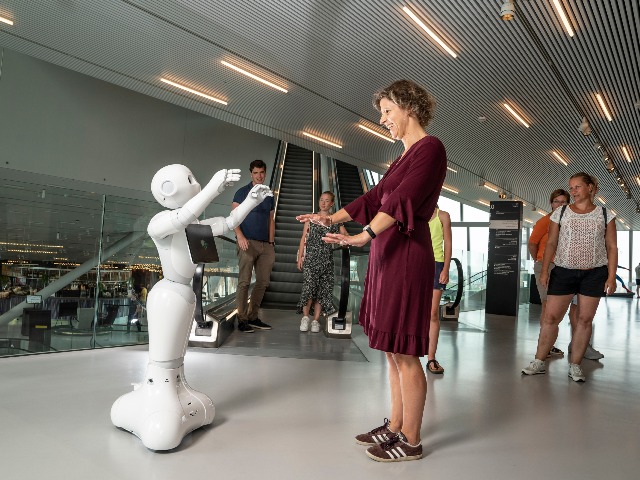Robots to the rescue?
| Date: | 16 March 2021 |

Social interaction between robots and humans is something we will have to get used to. In our health care system, investments in these robots are rising, especially during the covid-19 pandemic as it is harder to get enough personnel. The robots can fulfill functional tasks like cleaning a room or delivering a meal, but also social tasks to alleviate feelings of loneliness and social isolation, especially with elderly people. An advantage of using the robots during this pandemic is that they are less likely to be infected and easier to clean.
Although it is expected that social robots will be used more and more in public services, little is known about the acceptance of social robots by consumers.
Recently, Professor Jenny van Doorn and her team started a new research project that looks into the factors that determine the acceptance of these social robots.
Customer experience
Until now robotica-research mostly concentrated on functional improvements. However, while technology is an important tool to deal with the challenges within the health care system, the interface between the elderly and technology is still a struggle, in particular when a speech-based interface is used. Shortcomings lie not only in the intelligibility of the speech, but also in the extent to which the elderly are accepting and willing to use the technology.
Van Doorns research focuses on the question how consumers experience robotic services in a social context. To describe this phenomenon, van Doorn and her team introduced a new term: Automated Social Presence. This is the extent to which machines (e.g. robots) make consumers feel that they are in the company of another social entity.
She argues that the use of social robots is fundamentally different from previous technological innovations in public services. With social robots it is not only about the functional service itself, like the use of a cash machine, but also about the automation of the social interaction between robot and user. This last part was until recently, eminently reserved for humans.
Negative feelings
Her research shows that this kind of automation of social interaction in public services by consumers is mostly not accepted because robots evoke negative feelings.
“I didn’t expect that beforehand, but nearly all studies have shown that to be the case,” says Van Doorn. “When robots replace a waiter or receptionist, we often find it a bit creepy and experience it as a threat to our identity. It causes us more stress and discomfort than when we have to deal with a human worker.”
Making a robot more human-like by e.g. giving it a human name intensifies this negative reaction. Yet, when robots are used in a social context, in which people feel connected to others, like having drinks or other gatherings, negative reactions to robots are mitigated.
Dialect
From a societal perspective, social robots are not only important to healthcare organizations. Other public services are also looking at technological solutions to maintain their service, while dealing with decreasing budgets. The police, for example, is experimenting with robots recording minor offenses.
Given the enormous potential of robots van Doorn is determined to discover how robots can be used for these social tasks without evoking negative feelings. Her latest research focuses on the use of local dialects by the social robots. Together with local housing corporations and researchers from the UG’s Faculty of Arts, she wants to find out if this helps with the acceptance of the social robot by elderly people.
Van Doorn hopes that the use of robots will help ease the large strain on the health care system. “With an ageing population and rising life expectancy, the number of elderly people in need of care will exponentially increase. And when people get older, they can experience language loss and retreat to the language of their youth. This can be a foreign language, but also a local dialect.”
Her multi-disciplinary project investigates whether the intelligibility of speech and the acceptance of technological solutions can be improved if technology, in this case a robot, speaks to the elderly in their native language, to start with the local dialect in Groningen, “Gronings”.
Mid August van Doorn introduced the “Gronings” speaking robot via local TV and radio. Furthermore, locals could personally get to know the “Gronings” speaking robot in the Groninger Forum. For two days, the robot talked to around 150 visitors of the Forum Groningen in “Gronings”, but also Dutch. Van Doorn and her team asked the visitors of the Forum whether they found the Dutch or the “Gronings” dialect voice more pleasant and appealing. And last but not least, suggestions for a name for the still nameless robots were solicited from the public. Tammo and Aletta were the names that were most frequently suggested, but van Doorn and her team have not decided on a name yet.
Meeting the public
Part of her research is introducing the robot to the public. Especially, now that the robot is taught to “speak” in dialect, talking to locals is a fun way to see if the vocabulary of the robot is extensive enough. As you will discover in the video, both the robot and the public needed a little time to get used to one another.
Click here to watch the video.

